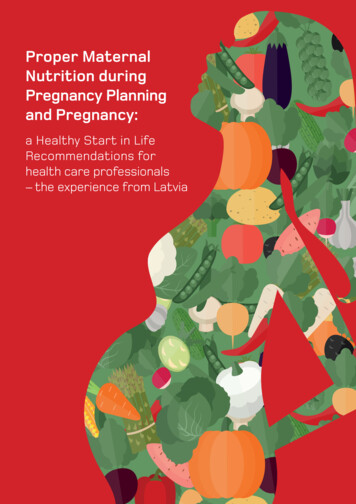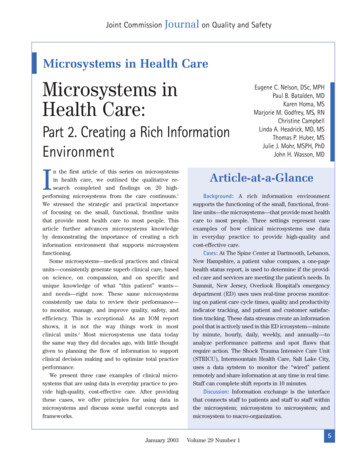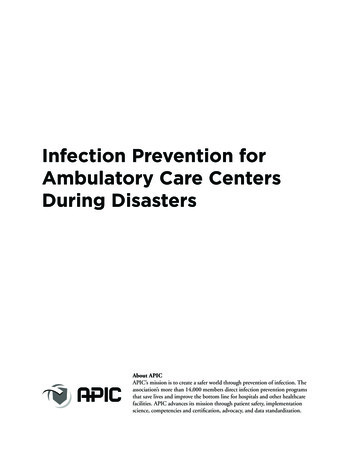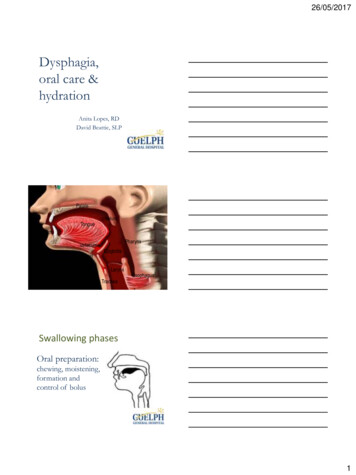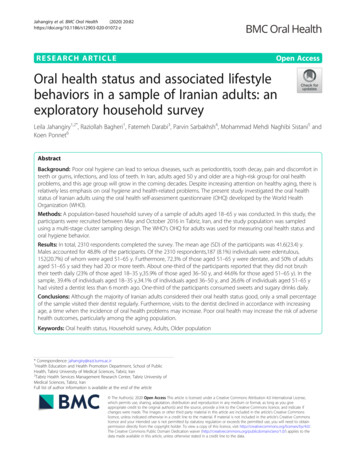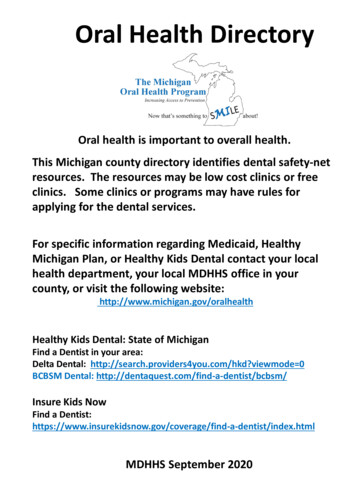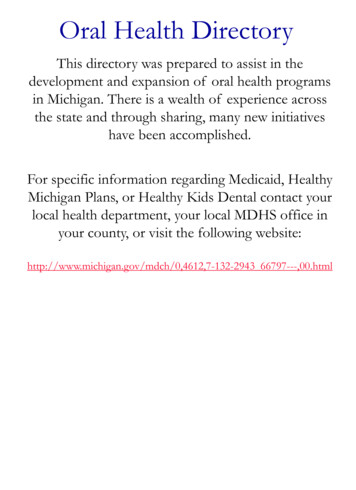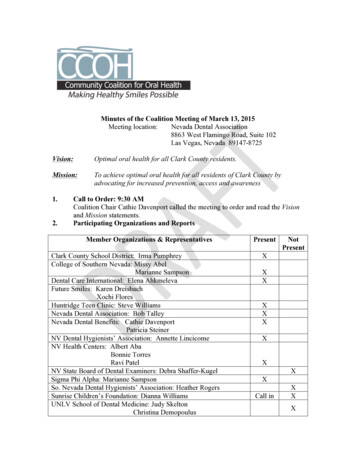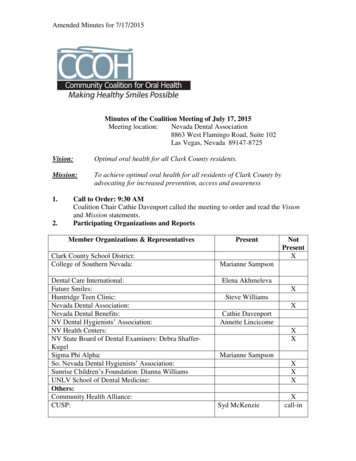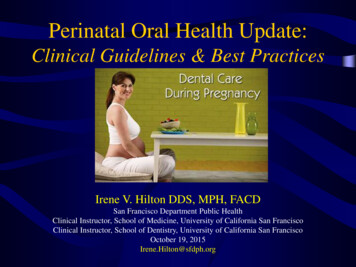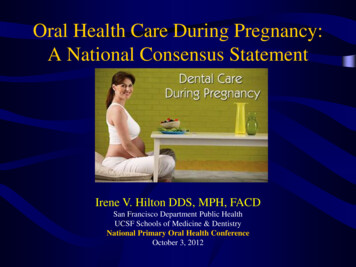
Transcription
Oral Health Care During Pregnancy:A National Consensus StatementIrene V. Hilton DDS, MPH, FACDSan Francisco Department Public HealthUCSF Schools of Medicine & DentistryNational Primary Oral Health ConferenceOctober 3, 2012
Objectives List 3 questions a perinatal provider shouldask a pregnant woman regarding her oralhealth Distinguish which medical conditions inpregnant women are indications for a medicalconsult Recognize which drugs are to be avoidedduring pregnancy Describe the importance of positioning withthe pregnant patient
Maternal Influence Diet Level of home care Importance of primary teeth & oralhealth Genetic & transmissibility components
MomChild
Opportunity At risk populations in contact with healthcare delivery system more frequentlythan usual Pregnant women may be interested intheir oral health & open to healtheducation messages May be only time have any type ofdental insurance coverage
Statements for Improving OralHealth During Pregnancy American Academy of Pediatric DentistryAmerican Academy of PediatricsAmerican Academy of PeriodontologyAmerican Academy of Physician AssistantsAmerican College of Nurse-MidwivesAmerican College of Obstetricians andGynecologists American Dental Association
Dental Care Utilization Pregnant women receive dental careless frequently than the general femalepopulation (Jiang et al, 2008) Women with both private dentalinsurance and Medicaid coverage utilizedental care more frequently when theyare not pregnant than when they arepregnant (Iida 2009, Thoele 2008)
Need For Guidelines- Patient Concerns regarding dental care notverbalized to perinatal providers Belief poor oral health status duringpregnancy is normal Low awareness of importance ofmaternal oral health and relationship toinfant’s long-term oral health
Need For GuidelinesPerinatal Providers Lack knowledge about the importanceof oral health status Not performing routine assessment andreferral of pregnant women into dentalcare Not enough information to providerationale why attending dental visits isimportant & respond to concerns
Need For GuidelinesDental Providers Insufficient training combined with lackof experience treating pregnant womenin dental school Concerns about the safety ofprocedures Addressing patient perceptions of risk Fear of malpractice suit if somethinggoes wrong with a patient’s pregnancy
Malpractice Myth TDIC- ten states & 17,000 insureddentists Reports one claim in the past 15 yearsblaming adverse birth outcome ondental treatment– No evidence for claim
Guidelines:NY, CA, WA, SC, AAPD
Consensus Statement 2008- HRSA/MCH convene expert panel onperinatal oral health Several recommendations on increasingaccess to oral health care for pregnantwomen One key recommendation was to conveneADA and ACOG to develop one set ofnational guidelines, instead of individual state& organizational guidelines
Consensus Development ExpertWorkgroup Meeting Oral Health Care During Pregnancy ConsensusDevelopment Expert Workgroup Meeting- October2011, Washington, DC– Health Resources and Services Administration/MCH/OHRC– American College of Obstetricians and Gynecologists– American Dental Association Reviewed policies, recent literature, and existingguidelines Identified common ground in the evidence basewhich resulted in the consensus statement
National ConsensusStatement Purpose Help professionals respond to the needfor improvements in the provision of oralhealth services to women duringpregnancy Bring about changes in the health-caredelivery system Improve the overall standard of care
Guidance for Prenatal CareHealth Professionals
Assess Oral Health Status Ask about oral health status- Pain?Bleeding? Ask if patient has a dental home Ask about last visit to dentist Check mouth for problems Document findings in medical record
Advise About Oral Health Care Facilitate oral health examination byidentifying dental provider Provide written medical clearance Ask if any concerns & address.Reassure women that oral health careis safe throughout pregnancy Encourage seeking oral health care,good oral hygiene, eating healthy foods
Collaborate with Oral HealthCare Professionals Establish relationships with oral healthprofessionals in the community anddevelop a formal referral process Share pertinent information aboutpregnant women, and coordinate care Integrate oral health topics into prenatalclasses
Guidance for Oral HealthProfessionals
Assess Oral Health Status Same as any comprehensive carepatient Oral health history Medical and dietary histories- use oftobacco, alcohol, and recreational drugs Perform comprehensive oral exam Take radiographs as clinically indicated
Advise About Oral Health Care Reassure women that oral health careis safe during pregnancy Encourage women to completetreatment, practice good oral hygiene,eat healthy foods, and attend prenatalclasses during pregnancy
Collaborate with PerinatalProviders Establish relationships with prenatalcare health professionals in thecommunity and develop a formalreferral process Share pertinent information aboutpregnant women, and coordinate care Consult with prenatal health careprofessionals, as necessary
Consult Indicated Co-morbidities that may affectmanagement- diabetes, pulmonaryissues, heart or valvular disease,hypertension, bleeding disorders, orheparin-treated thrombophilia Nitrous oxide needed for dentaltreatment Intravenous sedation or generalanesthesia needed
Provide DiseaseManagement & Treatment Provide emergency or acute care at anytime during pregnancy, as indicated bycondition Develop, discuss with women, andprovide comprehensive care plan Discuss benefits and risks of treatmentand alternatives
Provide DiseaseManagement & Treatment Use standard practice when placingrestorative materials Use rubber dam during endodonticprocedures and restorative procedures Position pregnant women appropriatelyduring care
Pharmacological Considerations AnalgesicsAntibioticsAnestheticsOver-the-Counter Antimicrobials All can be used
Clinical Guidelines
Dentist’s Concerns forSurgical Intervention/treatment X-raysNitrous oxideLocal anesthesiaRestorative materialsMedicationsPatient discomfort
Adverse Pregnancy Outcomes Risk of pregnancy loss before 20weeks: 15 - 25%. Most are notpreventable Risk of teratogenecity- up to 10 weeks– Rate of malformations - 3 to 4%
X-rays Radiographic imaging notcontraindicated– Very low levels of radiation– Thyroid collar and abdominal apron Should be utilized as required tocomplete full examination, diagnosisand treatment plan Standard of care
Nitrous Oxide Should be limited to situations wheretopical and local anesthetics areinadequate & care is essential Cost-benefit analysis Pregnant women require lower levels ofnitrous oxide to achieve sedation
Local Anesthesia Local anesthetic with epinephrine whenclinically indicated
Restorative Materials Amalgam– No evidence of harmful effect inpopulation based studies and reviews (FDA2009, CDC, NCI)– No additional risk if standard safe amalgampractices are used Resins– Short-term exposure associated withplacement has not been shown to havehealth risk; data lacking on the effects oflong-term exposures.
Drugs in PregnancyPhysiological Considerations Changes in pulmonary, gastrointestinaland peripheral blood flow can alter drugabsorption Hepatic changes can alterbiotransformation of drugs by the liverand clearance
Drugs in Pregnancy Study of W. VA pregnant women (Glover etal. 2003)– Average 1.14 prescription drugs, excludingvitamins and iron– Average of 2.95 over-the-counter drugs Tylenol, Tums, cough drops– Nearly half (45%) used herbal agents Peppermint, cranberry
Drugs in Pregnancy Category B (animal studies no risk & no adequate studiespregnant women OR animal studies adverse effect & wellcontrolled studies in pregnant women show no risk)–––––LidocaineAcetaminophenPen, amox, clindamycinNystatinChlorhexidine rinse Category C (adverse effect on animals & no studies onpregnant women)– Chlorhexidine chip– Codeine
Drugs in Pregnancy- Avoid NSAIDS (1st & 3rd) Erythromycin estolate Tetracycline
Patient Comfort Head higher thanfeet Upper archtreatment early inpregnancy beforelower arch Morning orafternoonappointmentpreference Breaks
Postural Considerations 3rd trimesterPosturalhypotensivesyndrome IVC impingement byweight of fetus Turn on side torestore circulation
The Other StuffPrevention & Maintenance
Fluoride OTC & Rx options
Chlorhexidine Suppress s. mutans & periodontal pathogensNon-alcohol formulationPatients rinse prior to appointmentAfter birth- 1 week of CHX followed by 3weeks of OTC Fl rinse (Spolsky et al. CDA Journal 2007) Cost/insurance coverage
Xylitol Naturally occurring sugar derived frombark of birch tree Suppresses s. mutans (Hildebrandt 2000) Studies show decreases transmission s.mutans (Soderling et al, 2000) Only way to insure therapeutic dose isdispense
Self Management Goals Basedon Risk Assessment Increasing & maintaining protectivefactors Reducing risk factors
Patient Education Materials Review for readinglevel and culturalappropriateness Keep materials brief Include larger print
Motivational Interviewing Mothers talk you listenGive choicesAcceptance facilitates changePressure to change facilitatesresistance Small steps
Resources Perinatal Oral Health http://www.cdafoundation.org/library/docs/news 030110a.htm http://cda.org/publications/journal of the california dental association/archive& search– September 2010 issue
Conclusion Pregnant women are experiencing anormal biological state and ethicallydeserve the same level of care as anyother patient Lack of knowledge and anecdotalconcerns influenced dental practice Evidence base shows appropriatedental care is necessary and safe
Our Goal
insurance and Medicaid coverage utilize . Fear of malpractice suit if something . Malpractice Myth TDIC- ten states & 17,000 insured dentists Reports one claim in the past 15 years blaming adverse b
